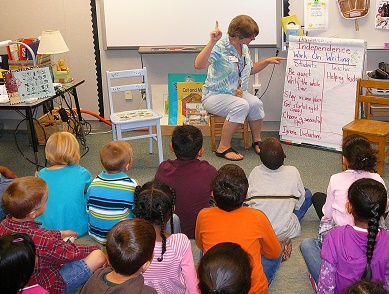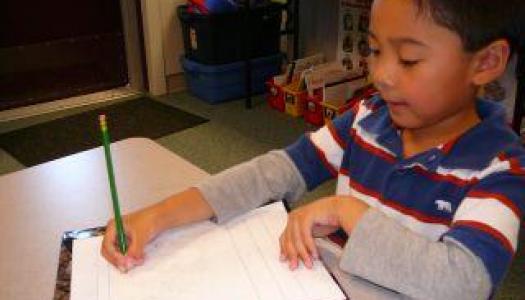Launching Daily 5 in Kindergarten, Part 5
Join Our Community
Access this resource now. Get up to three resources every month for free.
Choose from thousands of articles, lessons, guides, videos, and printables.

To best prepare students for the launch of Work on Writing in kindergarten, we must first introduce the foundation lessons. After the foundation lessons are secure, we start with the 10 Steps to Independence, and the creation of the Work on Writing I-chart.
In kindergarten, we follow the 10 Steps to Independence and build stamina to become better writers just as we do in other grades. Following the rule of thumb that average age=average length of lesson in minutes, we keep our focus lessons in kindergarten very brief, typically adding only two behaviors to the I-chart at a time.
Step 1: Identify what is to be taught—In a whole-group setting, the teacher writes a big I on chart paper and then writes "Work on Writing" at the top. The teacher reminds the children that the I stands for "Independence" and asks if they remember what it means. Then the teacher says, “Boys and girls, today we are going to learn to Work on Writing.”
Step 2: Set a purpose and create a sense of urgency—To keep this lesson brief and focused, we provide the purpose of the task to students. “We work on writing because it helps us become better writers. We all want to be better writers, don’t we?" (Yes) "We also Work on Writing because it is fun! Writing helps us remember important things and allows us to use our imaginations.”
Briefly review foundation lessons by asking the following:
- “The last few days we have learned that during Work on Writing we can write about anything we want. We created a list of ideas to help us. Where can we find this list?”
- “We also talked about what to do when we come to a word we don’t know. Who remembers what we should do when we come to a word we don’t know?”
Step 3: Record desired behaviors on an I-chart—Teacher records the desirable behaviors on the I-chart in front of the students and briefly explains each one. With younger students, we list and explain only the first two behaviors in the first sitting.
“Close your eyes and think about what it would look like and sound like if everyone was working on writing. One thing you would see is students writing the whole time." (Teacher writes, "Write the whole time" on the I-chart.) "This means that you would be using your pencil and paper and writing the entire time. Another thing you would see is everyone staying in one spot." (Teacher writes, "Stay in one spot.") "This means that once you sit down, you would not get up and move around, but you would stay in that spot the whole time. While you are working on writing, what am I doing? I am working with students.” (Teacher writes, "Working with students" on the teacher side of the I-chart.)
Step 4: Model most-desirable behaviors—Choose a student to model the behaviors listed on the I-chart. The teacher reads the behaviors on the student side of the I-chart and then asks the class if the student is modeling them correctly. Then the teacher asks the essential question, “Boys and girls, if ____ continues to do these things, will he become a better writer?”
Step 5: Model least-desirable behaviors—If you do not think your kindergarten class is ready for this step, you may wish to skip it so it does not confuse them about expectations. However, if you are launching after you have taught expected classroom behaviors, this step is a powerful way to communicate Work on Writing expectations to students. Be sure after a student models it the wrong way to have the same student turn his behavior around and model it the right way. (See more on p. 41 of The Daily 5 second edition.)
Step 6: Place students around the room—The first few days to a week, the teacher places students around the room, reminding them to pay close attention to how it feels so they can learn where they work best. This should move quickly for the best result. We usually place three or four students at a time, and we start with the students we think will have the strongest stamina.
Step 7: Practice and build stamina—Children practice and build stamina. This could be 30 seconds to a minute on the first day.
Step 8: Stay out of the way—Teacher trusts students and stays out of the way while students build stamina. This helps students learn independence and prevents them from relying on the teacher to keep them on task.
Step 9: Use quiet signal to bring students back to gathering space—Use a quiet signal to call children over to the gathering area. This should be reviewed and practiced ahead of time.
Step 10: Conduct a group check-in and ask, “How did it go?”—Older students typically use a four-point check-in. This can be used with kindergartners, or to simplify it, you may wish to have children give a thumbs-up for "good" and a thumbs-sideways for "needs work." We do not use thumbs-down because children are called back to the gathering area before they have a chance to practice poorly. After check-in, the teacher uses the stamina chart to graph the time achieved.
If stamina is broken after a very short time, you may wish to sound the chimes and quietly tell children to leave their things where they are and come to the gathering area. Revisit the I-chart, graph stamina, and send the children a few at a time back to their spots to practice again.
The second day of the launch looks much like the first, only more behaviors are added to the chart. This time the teacher adds Get started right away, Write quietly, and Build stamina. The 10 Steps are followed just as in Day 1.
The third day of the launch we typically revisit the I-chart (Step 3), may add "Ignore distractions" and "Build bathroom stamina," and then move to placing students around the room (Step 6).
Subsequent days resemble Day 3 until the class has achieved the desired stamina. Depending on class success, the teacher may choose to model again or refine behaviors. Typically on Day 4 or 5, the teacher will let the students who are ready choose a successful spot, with the goal of all students choosing their reading locations by the end of the launch.
Keep in mind, during the Work on Writing launch, both Read to Self and Work on Writing stamina building take place separately. Then, when desired stamina is achieved, choice is introduced.








